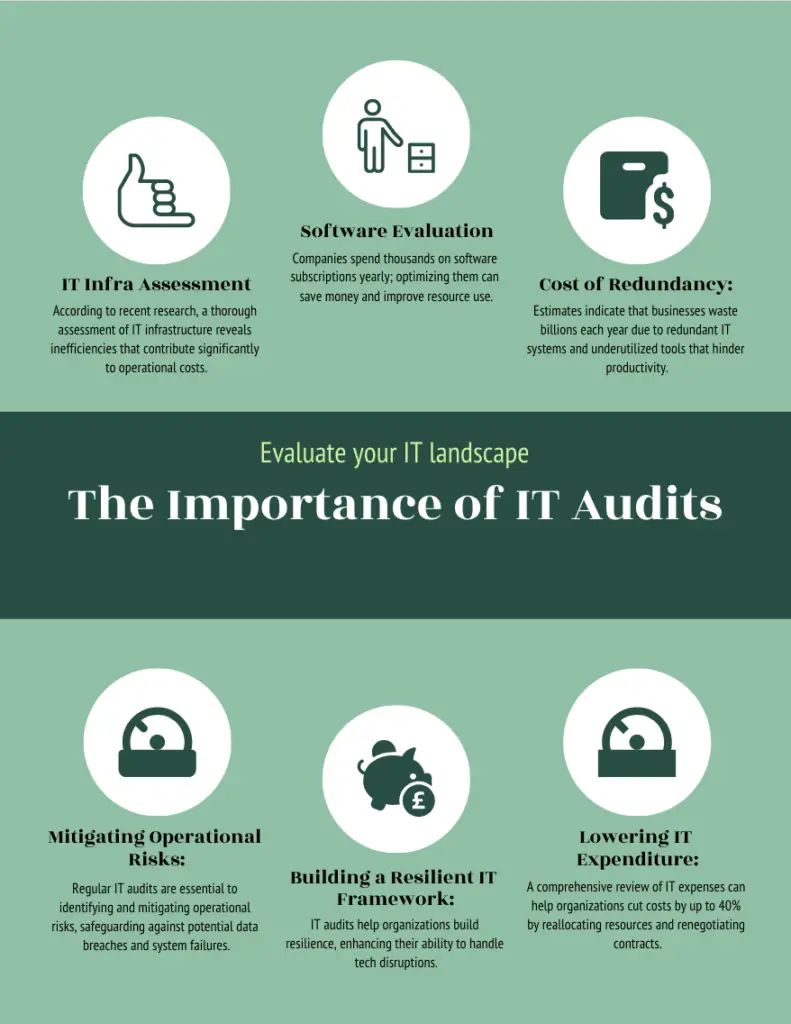The quest to streamline operations and cut unnecessary expenses remains a top priority for organizations. Addressing the realm of Information Technology (IT) spending can yield significant benefits in cost reduction and operational efficiency. This guide delves into five practical steps that can empower businesses to optimize their IT resources and enhance overall performance. By strategically managing IT costs, companies can not only save money but also boost productivity levels. From maximizing infrastructure utilization to harnessing the potential of cloud computing solutions, these strategies offer actionable insights to drive impactful organizational changes. Explore the world of IT cost optimization and efficiency enhancement to unlock new opportunities for growth and success.
Step 1: Conduct a Comprehensive IT Audit
Importance of Evaluating Current IT Infrastructure and Expenses
In the dynamic landscape of modern business operations, conducting a comprehensive IT audit holds paramount significance for organizations striving to boost efficiency, trim costs, and ensure peak performance. The process of evaluating the current IT infrastructure and expenses transcends a mere one-time activity; it evolves into a recurring practice, necessitating consistent scrutiny and evaluation. By immersing themselves in the depths of the IT ecosystem, businesses unveil invaluable insights into their technological frameworks, software applications, and operational procedures. This deep dive empowers them to make judicious decisions and strategic investments that resonate with their organizational objectives.
Guidance on Conducting a Thorough IT Audit to Identify Cost-Saving Opportunities
Embarking on the journey of an IT audit mandates organizations to embrace a structured methodology encompassing the diverse dimensions of their technological environment. Commence by constructing a comprehensive inventory of all IT assets, encompassing hardware components, software licenses, subscriptions, and cloud services. Evaluate the efficacy of existing systems to pinpoint inefficiencies and areas ripe for enhancement. Identify redundancies, underutilized resources, and security vulnerabilities potentially jeopardizing the organization’s operational integrity.
Furthermore, meticulous scrutiny of IT expenses and contracts is indispensable for unearthing opportunities to curtail costs. By dissecting spending trends, businesses can pinpoint areas where expenses can be rationalized, renegotiated, or reallocated. This may entail exploring alternate solutions, adopting cloud services, or harnessing open-source software to diminish licensing expenditures.
Adherence to the industry’s preeminent practices in IT auditing not only streamlines operations but also fortifies resilience, mitigates risks, and bolsters cybersecurity measures. Proficient IT audits lay the groundwork for a robust and future-ready IT infrastructure that harmonizes with business goals and fuels innovation.

Step 2: Embrace Cloud Solutions for Cost Efficiency
Transitioning to cloud-based services offers numerous benefits for businesses looking to streamline operations and reduce costs. Let’s delve deeper into the advantages of embracing cloud solutions to enhance cost efficiency within organizations.
Benefits of Transitioning to Cloud-Based Services for Cost Reduction
Cost reduction is a critical aspect of any business operation. Migrating to the cloud presents a significant opportunity for companies to cut costs in various ways. By moving to cloud services, organizations can eliminate the need for substantial upfront investments in hardware and infrastructure. Instead, they can opt for a pay-as-you-go model, paying only for the resources they utilize. This flexibility not only results in substantial savings but also allows businesses to allocate their financial resources more efficiently.
Exploring How Cloud Solutions Enhance Scalability
Scalability is a key benefit that cloud solutions offer. Businesses can easily scale their resources up or down based on demand, ensuring they always have the necessary computing power and storage capacity. This agility is particularly advantageous for companies experiencing fluctuating workloads or seasonal demands. By adjusting resources on the fly, organizations can optimize their costs while maintaining operational efficiency.
Improving Operational Efficiency with Cloud Solutions
Cloud services provide access to advanced tools and technologies that can significantly enhance operational efficiency. Features such as automated backups, real-time collaboration, and remote data access empower employees to work more productively, irrespective of their physical location. By leveraging these capabilities, businesses can streamline processes, boost productivity, and drive better business outcomes.
Embracing cloud solutions is a strategic decision for businesses aiming to enhance cost efficiency, scalability, and operational effectiveness. By transitioning to the cloud, companies can unlock many benefits that will contribute to their long-term success and competitiveness in the digital era.
Step 3: Optimize Software Licenses and Subscriptions
Managing Software Licenses and Subscriptions Efficiently for Cost Savings
Managing software licenses and subscriptions efficiently has become paramount for organizations striving for cost savings and operational efficiency. The strategic optimization of software assets not only helps in reducing unnecessary expenditures but also ensures that companies are leveraging their technology investments effectively. Here are essential steps and tips to optimize software licenses and subscriptions:.
- Regular Audits for Enhanced Utilization : Conducting periodic audits to track software usage across the organization is crucial. By identifying underutilized or redundant licenses, companies can reallocate resources effectively, leading to significant cost savings.
- Consolidation for Better Negotiation : Instead of maintaining multiple licenses for similar software products, consider consolidating them. Centralizing licenses gives organizations better negotiating power when dealing with vendors, enabling them to secure favorable deals and terms.
- Strategic Vendor Negotiation : During license renewal or procurement, negotiate with vendors to obtain advantageous terms. Bulk discounts, extended contracts, or tailored packages can help in optimizing costs and enhancing the value derived from software investments.
- Implementation of Usage Policies : Establishing clear software usage policies within the organization is essential. Educating employees on these policies ensures compliance and minimizes unnecessary expenses associated with misuse or unauthorized installations.
Tips on Optimizing Software Usage
In addition to managing licenses, optimizing software usage is critical for maximizing the benefits of technological resources. Here are key strategies to enhance software utilization:.
- Continuous Training Initiatives : Providing employees with regular training programs to enhance their software proficiency is vital. Improved skills not only boost productivity but also reduce errors, fostering a more efficient work environment.
- Regular Software Updates for Security : Ensuring that software applications are promptly updated is imperative to safeguarding against cyber threats. By staying current with updates, organizations can benefit from enhanced features and improved security measures.
- Investment in Monitoring Tools : Employing monitoring tools to track software usage patterns is beneficial. These tools aid in identifying optimization opportunities and preventing unauthorized software installations, ensuring compliance with licensing agreements.
- Feedback Mechanisms for Enhanced Performance : Encouraging employees to provide feedback on software usability and performance is valuable. This input helps identify areas for enhancement and refining software usage practices, ultimately increasing operational efficiency.
By implementing these proactive strategies and best practices, organizations can streamline their software licensing and subscription management, leading to notable cost savings, improved operational efficiency, and enhanced technology utilization.
Step 4: Implement Energy-Efficient Practices
Understanding the Impact of Energy Consumption on IT Expenses
Energy consumption plays a significant role in determining IT expenses. The electricity required to power servers, data centers, networking equipment, and other IT infrastructure components constitutes a substantial portion of operational costs for businesses. Understanding this impact is crucial for organizations looking to optimize their expenses and improve their overall sustainability.
Recommendations for Adopting Energy-Efficient Strategies to Reduce Costs
To address the challenges posed by high energy consumption, businesses can implement various energy-efficient strategies. One effective approach is adopting virtualization technology, which enables the consolidation of multiple virtual servers onto a single physical server, thereby reducing overall energy usage. Cloud computing services also offer opportunities to optimize resource utilization and minimize energy waste.
Furthermore, selecting energy-efficient hardware components, such as processors, storage devices, and networking equipment, can contribute to significant cost savings over time. Businesses should also consider implementing power management tools and practices to monitor and control energy usage across their IT infrastructure.
In addition to technology-focused solutions, optimizing cooling systems within data centers can lead to substantial energy savings. Implementing best practices in cooling design, such as using efficient cooling techniques and airflow management strategies, can help reduce the overall power consumption of IT facilities.
By prioritizing energy efficiency in their IT operations, businesses not only stand to benefit from cost reductions but also play a crucial role in promoting environmental sustainability. Embracing energy-efficient practices is not just a financial decision but a commitment to building a greener and more sustainable future for future generations.
Importance of Employee Training and Awareness
Apart from technological solutions, fostering a culture of energy efficiency within the organization is essential. Employee training programs can raise awareness about the importance of energy conservation and encourage staff members to adopt best practices in their daily operations. Simple actions like turning off unused equipment, optimizing computer settings for energy savings, and reducing paper waste can all contribute to a more sustainable workplace.
Monitoring and Evaluation
Regular monitoring and evaluation of energy consumption patterns are vital for identifying areas of improvement and tracking progress towards energy efficiency goals. Implementing energy monitoring tools and conducting periodic energy audits can provide valuable insights into usage trends and help in identifying opportunities for further optimization.
Collaboration and Industry Partnerships
Collaborating with industry partners and suppliers who prioritize sustainability can also enhance an organization’s energy efficiency efforts. By selecting vendors that offer energy-efficient products and services, businesses can align their sustainability goals with those of their partners, creating a more environmentally conscious supply chain.
Setting Clear Targets and Goals
Establishing clear targets and goals for energy efficiency can provide a roadmap for organizations to work towards. Setting achievable milestones and regularly reviewing progress can help maintain momentum and ensure that energy-saving initiatives remain prioritized within the organization.
Implementing energy-efficient practices in IT operations is not only a strategic approach to cost management but also a significant step towards environmental responsibility. By combining technological solutions with employee engagement, monitoring mechanisms, collaboration with industry partners, and goal setting, businesses can create a comprehensive energy efficiency strategy that benefits both their bottom line and the planet.
Investing in employee training and productivity tools is paramount for the success of any organization, particularly in the dynamic realm of Information Technology. This section delves into the criticality of valuing skilled employees as fundamental to enhancing IT efficiency and advocates for strategic investments in training and productivity tools to foster workforce development.
Recognizing Skilled Employees: A Catalyst for Success
Identifying Key Players
- Unleashing Potential: Emphasize the significance of pinpointing employees with exceptional skills and innate capabilities within the organization.
- Valuing Contributions: Acknowledge and celebrate the invaluable contributions these skilled individuals bring to the table, driving innovation and progress.
- Cultivating Appreciation: Foster a culture that not only recognizes talent but also actively rewards and promotes it, inspiring others to excel.
Empowering Your Team for Enduring Success
- Facilitating Growth: Offer avenues for personal and professional growth, enabling employees to realize their full potential and contribute meaningfully.
- Mentorship Programs: Implement mentorship initiatives and conduct skill-building workshops to nurture talent and expertise within the workforce.
- Supportive Environment: Cultivate an environment that thrives on continuous learning, where curiosity and knowledge acquisition are encouraged and supported.
Investing in Training and Productivity Tools: Paving the Path to Excellence
Continuous Learning for Ongoing Innovation
- Staying Ahead: Stress the importance of staying abreast of the latest industry technologies and trends to remain competitive and relevant.
- Training Initiatives: Invest in comprehensive training programs and certifications to upskill employees and broaden their expertise.
- Professional Development: Encourage and facilitate participation in professional development opportunities to enhance knowledge and skill sets.
Leveraging Productivity Tools for Enhanced Efficiency
- Streamlining Processes: Introduce cutting-edge tools and software solutions aimed at streamlining operations and optimizing workflow efficiencies.
- Automation for Speed: Automate repetitive tasks to save valuable time and resources, boosting productivity and output.
- Resource Accessibility: Provide employees with access to resources and tools that bolster productivity and facilitate seamless collaboration.
By strategically allocating resources towards employee training and deploying productivity tools, organizations can not only bolster IT efficiency but also cultivate a culture of innovation and continuous improvement within their workforce. It is imperative to recognize the invaluable contributions of skilled employees and equip them with the necessary tools and support to thrive in the fast-paced landscape of modern IT.
Conclusion
By implementing the five simple steps outlined in this blog, businesses can effectively cut IT costs and boost efficiency. From leveraging cloud services to optimizing software licenses, each step provides a practical and strategic approach to improving IT operations. By prioritizing cost-saving measures and streamlining processes, organizations can not only reduce expenses but also enhance productivity and competitiveness in today’s rapidly evolving digital landscape. Taking proactive steps to manage IT costs will ultimately lead to a more agile and resilient business model that is better equipped to navigate the challenges and opportunities of the digital age.





